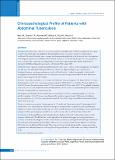Please use this identifier to cite or link to this item:
https://hdl.handle.net/20.500.14356/1992| Title: | Clinicopathological Profile of Patients with Abdominal Tuberculosis |
| Authors: | Miah, A R Sharma, Y P Rahman, M T Raihan, A Roy, P K Hasan, M |
| Citation: | MiahA. R., SharmaY. R., RahmanM. T., RaihanA., RoyP. K., & HasanM. (2011). Clinicopathological Profile of Patients with Abdominal Tuberculosis. Journal of Nepal Health Research Council. https://doi.org/10.33314/jnhrc.v0i0.282 |
| Issue Date: | 2011 |
| Publisher: | Nepal Health Research Council |
| Article Type: | Original Article |
| Keywords: | Abdomen Tuberculosis |
| Series/Report no.: | October;282 |
| Abstract: | Abstract Background: Tuberculosis (TB) is not an uncommon problem throughout the world particularlyin the developing countries like Nepal, India and Bangladesh. Abdominal Tuberculosis accounts for nearly 2% of tuberculosis worldwide. The aim of this study was to evaluate the clinicopathological profile with the help of other investigations in the diagnosis of patients with abdominal TB and their response to anti-tubercular therapy. This was a prospective cross-sectional study conducted in the department of Gastroenterology, Bangabandhu Sheikh Mujib Medical University (BSMMU), Dhaka during the period of October 2002 to June 2009. Methods: Total 53 patients with abdominal TB diagnosed on the basis of clinical profile and supported investigation data like gross morphological findings at endoscopy, colonoscopy, diagnostic laparoscopy, laparotomy or histologically proven caseating granulomas were selected for this study. Detailed demographic, clinical profile, investigations and treatment response were recorded properly in a predesigned data collection sheet which were analyzed and compared with other studies. Results: TOut of the 53 patients, 33 were males and 20 females with age ranging 16-70( Mean 30.01±11.7) years. Abdominal pain was the most common presenting symptom in 47(88.68%), fever in 45(84.9%) and weight loss in 37(69.81%) cases. Anemia was found in 41(77.36%), cachexia 40(75.47%), ascites 20(37.74%), palpable abdominal mass in 14 (26.42%) and features of intestinal obstruction in 5(9.43%) cases. Five patients had positive family history of TB and five had past history of pulmonary TB. The diagnosis of abdominal TB was confirmed microscopically in 5 (9.43%), histopathologically in 31(58.49%) and the remaining 17 (32.07%) cases were diagnosed by a positive response to anti –TB therapy. According to site of involvement, 31 (58.51%), patients had intestinal TB, 9(16.98%) had peritoneal TB and disseminated TB in 20(37.74%) of the case. Twenty seven patients were given 3 drugs regimen for 12 months and 26 patients received 4 drugs regimen for 9 months under close supervision. By 9 months of therapy 51 patients become symptom free and no pathological findings were observed thereafter at follow up visits after 6 months. Response was not satisfactory in two patients and subsequent follow up investigation revealed to have crohn’s disease rather than TB and none of them died. Conclusions: Abdominal TB is an important clinical entity having varied mode of clinical presentation. So the diagnosis of abdominal TB is difficult and careful approach to the patients and supportive investigation data are necessary to make the final diagnosis. Neither clinical features, laboratory, radiological and Endoscopic methods nor bacteriological and histopathological findings by themselves provide a gold standard in the diagnosis of abdominal TB. In this series of abdominal TB, intestinal TB was the most frequent clinical type and the common presenting symptoms were abdominal pain,fever and weight loss.If diagnosed early, it can be treated successfully with anti-TB drugs. Keywords: abdomen ,tuberculosis |
| Description: | Original Article |
| URI: | http://103.69.126.140:8080/handle/20.500.14356/1992 |
| ISSN: | Print ISSN: 1727-5482; Online ISSN: 1999-6217 |
| Appears in Collections: | Vol 9 No 2 Issue 19 October 2011 |
Files in This Item:
| File | Description | Size | Format | |
|---|---|---|---|---|
| 282-Article Text-280-1-10-20130822.pdf | Fulltext Download | 639.83 kB | Adobe PDF |  View/Open |
Items in DSpace are protected by copyright, with all rights reserved, unless otherwise indicated.
